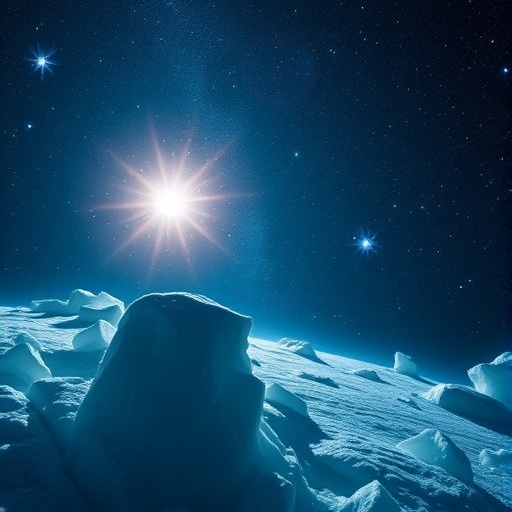In a groundbreaking breakthrough that promises to redefine our comprehension of the cosmic distribution of life’s fundamental chemical ingredients, astronomers have identified organic molecules containing more than six atoms, solidified in ice formations around a nascent star designated ST6. Remarkably, this discovery extends beyond the confines of our own Milky Way galaxy, being made in the Large Magellanic Cloud, a neighboring galaxy that provides vital insights into star formation and molecular chemistry beyond our immediate cosmic vicinity.
Harnessing the unparalleled capabilities of the James Webb Space Telescope (JWST), specifically its Mid-Infrared Instrument (MIRI), an international team of researchers led by Marta Sewilo from the University of Maryland and NASA has meticulously uncovered five distinct carbon-based compounds encased in ice surrounding the young protostar ST6. This detection marks an unprecedented observational leap, detailed in a study published in the prestigious Astrophysical Journal Letters on October 20, 2025. The Large Magellanic Cloud, located approximately 160,000 light-years from Earth, offers a unique environmental laboratory similar to the early universe’s conditions, making these findings particularly significant.
Among the identified complex organic molecules (COMs) are methanol and ethanol, familiar alcohols widely prevalent on Earth, alongside industrially relevant compounds such as methyl formate and acetaldehyde. Most notably, the research marks the first definitive detection of acetic acid—integral to vinegar—in space ice, a molecule previously elusive in extraterrestrial solid phases. Additionally, spectral data indicate the possible presence of glycolaldehyde, a simple sugar-related molecule and critical precursor to RNA components, although further analysis is necessary for confirmation. Such molecules hold profound implications for astrobiology due to their role in the chemical pathways leading to life.
The crux of this discovery hinges on JWST’s extraordinary sensitivity coupled with exceptionally high angular and spectral resolution. These characteristics allow the telescope not only to detect faint spectral signatures from distant protostellar ices but also to discern the molecular fingerprints with unprecedented fidelity. According to Sewilo, prior to JWST’s operation, methanol was the sole complex organic molecule conclusively observed within ices surrounding protostars, even within our own galactic neighborhood. This advancement represents a monumental augmentation in spectral acquisition quality, enabling exhaustive chemical analysis from a solitary observation.
A particularly compelling aspect of this study resides in the extremity of the Large Magellanic Cloud’s environment. Characterized by subsolar metallicity—meaning it possesses only one-third to one-half the abundance of elements heavier than helium found in our solar system—and subjected to intense ultraviolet radiation, this galaxy serves as an analog to primordial cosmic conditions. Such a milieu challenges conventional theories, affirming that complex organic chemistry can thrive even where foundational elements for life are considerably scarcer and radiation levels markedly higher.
Understanding the implications for cosmic chemical evolution, Sewilo emphasized that low-metallicity environments resemble galaxies from earlier cosmological epochs. Insights gleaned from the Large Magellanic Cloud, she argued, could be extrapolated to interpret the chemical frameworks prevalent in distant, young galaxies of the universe. This raises intriguing possibilities regarding the formation and persistence of life’s molecular building blocks in environments that were once deemed inhospitable due to elemental paucity and harsh radiation fields.
Co-author Will Rocha, based at Leiden University, elaborated on the formation mechanisms behind these complex molecules. COMs arise through chemical reactions in both gas phases and on icy surfaces enveloping interstellar dust particles. After solid-state synthesis, these molecules may liberate into gaseous environments, as previously observed with methanol and methyl formate in the Large Magellanic Cloud’s gas phase. Laboratory simulations and computational models corroborate that surface chemistry on dust grains is the primary driver of complex molecule synthesis, a hypothesis reinforced by the detection of solid-state COMs in such a challenging environment.
This revelation affirms that the formation of organic molecules, precursors to biologically relevant species, is a robust process even under conditions markedly different from our own galactic vicinity. It underscores the universality of chemical pathways potentially leading to life’s essential components, suggesting that interstellar chemistry conducive to biogenesis may be more widespread and resilient than formerly postulated.
Equally provocative is the implication that these complex organic molecules could survive the tumultuous processes of planetary system formation. If these icy molecules endure through their integration into emerging planets, they may supply the primordial chemical toolkit necessary for the genesis of life. While direct evidence of extraterrestrial life remains elusive, such chemical veracity in diverse environments bolsters the hypothesis that life’s molecular precursors are omnipresent and durable across the cosmos.
Looking ahead, Sewilo and her colleagues intend to broaden their investigational scope to encompass additional protostars within both the Large and Small Magellanic Clouds. Expanding the sample size is critical to verifying observed differences in COM abundances between our galaxy and its neighbors, contributing to a more comprehensive framework of astrochemical evolution. This research selection also underscores the necessity for nuanced, comparative studies across disparate galactic environments to unravel the cosmic pathways leading to life’s chemistry.
Presently, only a handful of sources feature detected complex organic molecules in ices, both within the Milky Way and externally. Confidence in overarching conclusions about molecular distribution and abundance differences awaits larger datasets. Nevertheless, the current discovery stands as a monumental stride in understanding the emergence and evolution of complex chemistry in varied cosmic locales, providing vital clues about the universe’s capacity to generate and nurture life’s chemical foundations.
This landmark study not only bolsters our knowledge of interstellar chemical complexity but also invigorates the scientific quest to decipher life’s cosmic origins. By illuminating the chemistry of early-universe analog environments, it opens unprecedented avenues for exploring how life’s essential molecules arise and disperse in the universe, reshaping foundational paradigms in astrochemistry and astrobiology.
Subject of Research: Astrochemical analysis of protostellar ices in low-metallicity extragalactic environments.
Article Title: Protostars at Subsolar Metallicity: First Detection of Large Solid-State Complex Organic Molecules in the Large Magellanic Cloud
News Publication Date: October 20, 2025
Web References: https://doi.org/10.3847/2041-8213/ae0ccd
References: Sewilo, M., et al. (2025). Protostars at Subsolar Metallicity: First Detection of Large Solid-State Complex Organic Molecules in the Large Magellanic Cloud. Astrophysical Journal Letters.
Image Credits: NASA/ESA/CSA/JPL-Caltech/M. Sewiło et al. (2025)
Keywords: Astrochemistry, Organic compounds, Astronomy, Early universe, Observable universe, Space exploration, Astrobiology, Habitable planets, Galaxies
Tags: carbon-based compounds in icecomplex organic molecules in spacecosmic distribution of organic compoundsextraterrestrial organic chemistrygroundbreaking astronomy researchimplications for life’s building blocksinterstellar molecular chemistryJames Webb Space Telescope findingsLarge Magellanic Cloud discoveriesorganic molecules in iceST6 protostar researchstar formation in nearby galaxies



